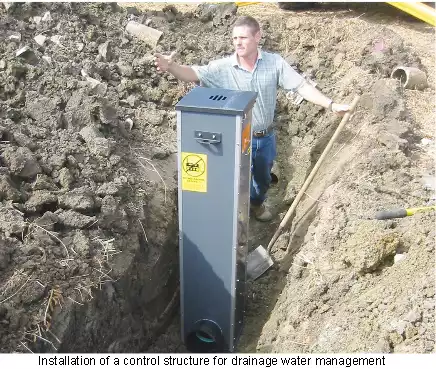Drainage Water Management CSCAP Speed Science Fact Sheet
Summary
The Drainage Water Management Fact Sheet (Acrobat (PDF) 937kB Oct8 15) are approved for use in educational, research and extension settings. Numerous fact sheets were developed and presented as "Speed Science" by the Climate and Corn-based Cropping Systems CAP (CSCAP). The additional factsheets are found on the SERC site.
The CSCAP is a transdisciplinary partnership among 11 institutions creating new science and educational opportunities. It seeks to increase resilience and adaptability of Midwest agriculture to more volatile weather patterns by identifying farmer practices and policies that increase sustainability while meeting crop demand.
Printable flyer >> About CSCAP Project (Acrobat (PDF) 2.9MB Oct8 15)
Learning Goals
To promote the long-term sustainability and productivity of U.S. corn-based cropping systems against recent climate trends and future uncertainty.
Project Objectives:
- Develop standardized methodologies and perform baseline monitoring of carbon, nitrogen and water footprints at agricultural test sites across the Midwest.
- Evaluate how crop management practices impact carbon, nitrogen and water footprints at test sites.
- Apply models to research data and climate scenarios to identify impacts and outcomes that could affect the sustainability and economic vitality of corn-based cropping systems.
- Gain knowledge of farmer beliefs and concerns about climate change, attitudes toward adaptative and mitigative strategies and practices, and decision support needs to inform the development of tools and practices that support long-term sustainability of crop production.
- Promote extension, outreach and stakeholder learning and participation across all aspects of the program.
- Train the next generation of scientists, develop science education curricula and promote learning opportunities for high school teachers and students.
Context for Use
Description and Teaching Materials
Pages / Length: 2
Publication Date: 08/2014Printable handout pdf >> Speedscience: Drainage Water Management Fact Sheet (Acrobat (PDF) 937kB Oct8 15)
Subsurface tile drainage, which is used to enhance crop yields on naturally poorly-drained soils, is an important component of crop production in the Midwest. Because nitrate loads from tile-drained fields have been shown to contribute to hypoxic conditions in the Gulf of Mexico, conservation practices are needed to reduce nitrate loss while maintaining drainage function during the cropping season. Drainage water management is the practice of using a water control structure in a drain to raise the drainage outlet during parts of the year when a higher water table will not harm and may benefit the crop, resulting in reductions in nitrate load to ditches and streams and potential increases in crop yield.
Water quality benefits from reductions in annual nitrate load in drain flow has ranged from about 15% to 75% in published studies, depending on location, climate, soil type, and cropping practice. This nitrate load reduction is due to the reduction in drain flow volume and to potentially higher denitrification with more soil anaerobic conditions. Crop yields can also increase with drainage water management, if rainfall is timely and the outlet is well managed. Yield increases from 5% to 10% have been found, although published studies are quite limited. Effects on carbon are even more uncertain. We expect that if the crop yield improves, more carbon would likely be sequestered in the soil. In addition, a wetter soil would be expected to reduce decomposition of organic matter, and therefore slowly build organic carbon. Studies to establish these effects are just beginning. Although drainage water management adoption is limited, it is being encouraged through training in the design and installation of drainage management systems, education of landowners, and financial incentives provided by state and federal conservation programs.
| Figure 1-4:(1) Tile drainage is critical to crop production, but nitrate loss is a concern. Drainage water management improves water quality as the outlet or control structure is(2) raised after harvest until early spring to reduce nitrate loss during the off-season,(3) lowered so the drain can flow freely before field operations such as planting or harvest, and(4) raised again after planting and spring field operations to create a potential to store water that could be used by the crop. |
Teaching Notes and Tips
The Drainage Water Management Fact Sheet (Acrobat (PDF) 937kB Oct8 15) is a quick reference with graphs and charts showing increasing greenhouse gas concentration. The full collection of CSCAP Fact Sheets and Speed Science Presentation Videos are found on the SERC site.
Assessment
Assessment is at the discretion of the educator and how the Speed Science Fact Sheets are applied.
References and Resources
Jane Frankenberger, Purdue University, CSCAP Fact Sheet
Project Partners:
- Iowa State University
- Lincoln University
- Michigan State University
- The Ohio State University
- Purdue University
- South Dakota State University
- University of Illinois
- University of Minnesota
- University of Missouri
- University of Wisconsin
- USDA Agricultural Research Service–Columbus, Ohio
- USDA National Institute of Food and Agriculture (USDA-NIFA)


![[reuse info]](/images/information_16.png)